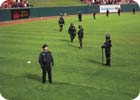Image Counts

“We have continually set the industry’s benchmark for
performance with new technologies that deliver exceptional imaging capabilities
and features, along with proven quality and reliability,” said Frank DeFina,
president, Panasonic System Solutions.
Security Magazine interviewed Frank DeFina, president, Panasonic System Solutions Company, for this special edition of Visions, which provides a platform for CEOs and presidents at top security technologies to talk about developments that impact CSOs and security directors. Panasonic continues to expand the breadth of its video surveillance solutions in such areas as IP, Super Dynamic III technology, enhanced Digital Signal Processing with Adaptive Black Stretch technology, among other industry advances.
Security Magazine: What is your view of the current market?
DeFina: There is no doubt that the market is moving towards a networked platform with the transition gaining traction at a moderate pace as systems are created, replaced and expanded. Panasonic Security Systems continues to support this trend with the development and implementation of IP based system solutions employing our i-Pro intelligent and professional IP video surveillance products. This year we have added significantly to this line, and believe we offer the most advanced and comprehensive suite of IP solutions available. Nevertheless, given the ongoing prevalence of analog systems, both legacy and new, we remain committed to developing innovative solutions in this market segment as well. Analog systems will continue to hold their ground in the near future, particularly where matrix switching systems are required to manage systems with large numbers of cameras.
Another market trend that is an important area of concentration at Panasonic is technology integration. We have the advantage of a parent company with a long, proven history in electronics, giving us access to R&D spanning numerous market segments. Additionally, Panasonic Security Systems has amplified our ability to develop new capabilities by implementing our “Open Infrastructure” initiative, partnering with specialized companies both within and outside of the traditional security market. Like a number of manufacturers, we see the benefit of working together with technology leaders to capitalize on our respective core expertise. By forming these partnerships, we can better focus our efforts to achieve the levels of integration necessary for true convergence, which will further aid in developing intelligent migratory solutions for the large installed base of analog surveillance system users.

Stadium operations systems administrator Hosei Maruyama and
vice president of operations Joe Abernathy at Busch Stadium.
DeFina: The first job for the end user is to understand the definition of the network and what is being offered by the various companies selling network solutions. Panasonic does not provide the network itself; we provide video surveillance solutions that reside on the network. This is the key message for our i-Pro solutions: it’s what’s on your network that counts.
Although the network platform is relatively new to the security industry, networks have been a reality for many years in other areas of business, and the technology of implementing a network, while constantly evolving, is well-established. With the evolution of network capabilities that accommodate broadband video, voice and data simultaneously, the dynamics of system design and functionality have changed dramatically. Unlike analog systems, which allow various security systems to interface with one another, with networked systems it is now possible to actually integrate various facility systems on a single control platform with some degree of automated intelligence.
Users need to assess first what their actual technology needs are, something for which a dealer or systems integrator can be an invaluable resource. Panasonic works with a nationwide group of select integrators – Panasonic Premier Integrators – who are well-versed in networked systems and the i-Pro product lineup, and can assist in determining the extent of a user’s needs as well as what existing equipment already can be integrated into the solution.

Security was tight for the World Series games played at Busch
Stadium.
Photo Credit: Satoshi Kitahama,
courtesy of St. Louis
Cardinals
DeFina: Image acquisition is the primary job of any video surveillance system, a function for which Panasonic maintains a leadership position on both IP and analog system platforms. We invented Super Dynamic (SD) technology, which is now in its third generation, to provide superior imaging performance. SDIII captures images in virtually any lighting condition, plus it incorporates built-in intelligent technology like Auto Back Focus and Auto Image Stabilization. Our recent integration of SDIII imaging with our newest i-Pro Series IP cameras is an example of how Panasonic is bringing strong analog technology together with network capabilities to meet evolving market needs.
Right now we are also hearing a lot of buzz about megapixel capabilities on a networked platform, something that was previously unattainable with existing technology. Ultimately all video surveillance issues come back to the ability to make a positive identification, hence the ongoing drive across all areas of the industry to improve image quality. With Panasonic’s long history of expertise in this area, we are well positioned to lead the market in offering a range of superior imaging solutions.
Security Magazine: What kind of distribution strategy can a manufacturer put into place to best serve the needs of the end user seeking to enter a rapidly changing market?
DeFina: As I mentioned, experienced systems integrators offer the best opportunity for users to navigate this market. This is the reason we created the Panasonic Premier Integrator program to support those dealer/integrators that excel in the deployment of advanced systems technologies. We support the Panasonic Premier Integrators through manufacturers’ rep organizations, dedicated headquarters staff, and numerous training programs and materials provided by Panasonic to keep them fully up to date and ready to help meet the needs of most any application.
We encourage our customers to seek out the assistance of Panasonic Premier Integrators both in determining their specific needs and throughout the design and installation process. This also helps us to keep a more direct connection with the user in the field, to continue to provide the level of support and customer service that is a primary objective.

Stadium operations systems administrator Hosei Maruyama checks the Panasonic NVRs in Busch Stadium.
SIDEBAR: World Champs at Security, Too
David Eckstein may have been named the Most Valuable Player when St. Louis won the World Series last October. But Cardinals in the know also realize the major league success played by Joe Abernathy and Hosei Maruyama.Abernathy is vice president of operations and Maruyama, stadium operations systems administrator, were key players who brought the new Busch Stadium a brand new, cutting-edge security system in April 2006. Still, as the team approached the playoffs, it became more evident that some additions and changes would be required. When the Cardinals reached the division series, Major League Baseball also became involved, bringing in their own security personnel to coordinate with Busch Stadium personnel.
The day after the team won the National League Championship, stadium management had a meeting with officials from the City of St. Louis which included local law enforcement and fire department personnel. State and Federal agencies also participated in the meeting, including the FBI, Alcohol Tobacco and Firearms (ATF) and the Coast Guard. This meeting organized the efforts of all these agencies to provide security and emergency response plans for the World Series games to be held at Busch Stadium.
The number of personnel increased in and around the facility, to provide front line security and preparation checks. There was also a thorough inspection of the facility, with sweeping bomb squad teams a couple of hours every day. During the games, K-9 and bomb tech teams were staged on site, keeping all their equipment and dogs at the stadium. Hazardous materials teams were deployed as well. “Sniffers” were positioned strategically around the stadium to check on an ongoing basis and determine if there was anything in the air that could cause a problem – chemical or biological.
When St. Louis got close to clinching the World Series Championship, Civil Disturbance Teams (CDT) were brought in to line the field after the win and to help maintain control of the estimated 2,000 people that had gathered around the stadium.
Because the new Panasonic video surveillance system at Busch Stadium is IP based, Maruyama was able to set up a secure VPN into the network which provided the FBI with fast and easy access to the camera system. With this, they were able to monitor everything that stadium security personnel were watching, using a projection system and several monitors. “The Panasonic IP system made it easy and convenient to provide the FBI with eyes into the facility from a few blocks away,” added Abernathy.
Cameras are controlled using a unique virtual matrix switching system. A significant element of the original design criteria was to take advantage of the Ethernet backbone.
Looking for a reprint of this article?
From high-res PDFs to custom plaques, order your copy today!




